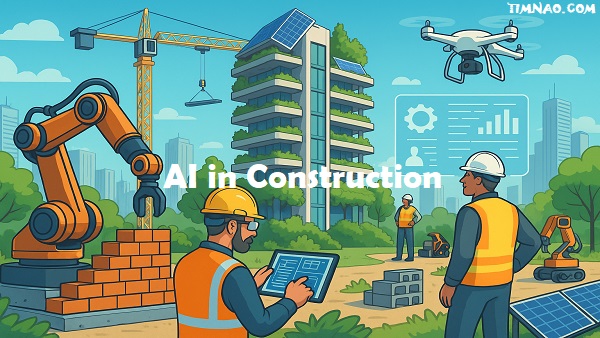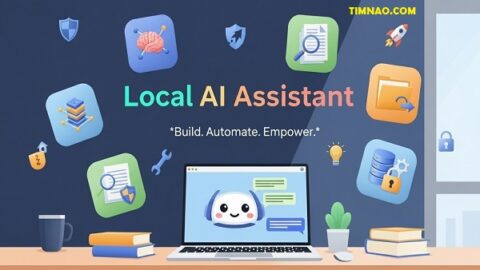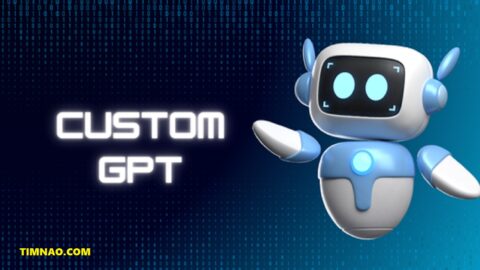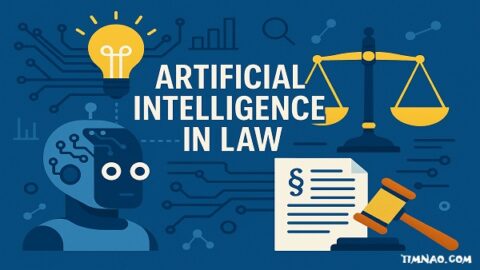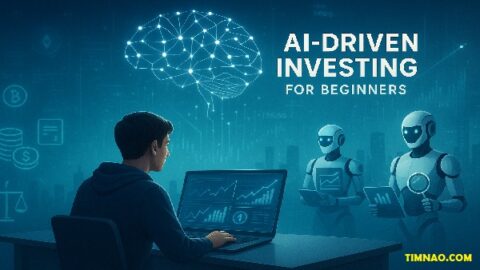🏗️ AI Disruption in Construction: Why the Smart Future Starts Today 💥🚧
AI in construction is no longer just a buzzword—it’s a bold revolution that’s transforming one of the world’s oldest and most essential industries. As the pressure mounts to build faster, smarter, and more sustainably, artificial intelligence is stepping in to do what traditional methods cannot: streamline design, prevent delays, reduce costs, and even save lives.
From robots that lay bricks with machine precision to algorithms that predict project risks before they happen, AI is redefining how we plan, build, and manage everything from homes to highways. Whether you’re a curious beginner, a forward-thinking contractor, or a decision-maker in construction tech, understanding this seismic shift isn’t just useful—it’s crucial.
In this guide, we’ll explore powerful ways AI is shaping the future of construction in 2025 and beyond. You’ll find practical examples, real-world success stories, and insights to help you stay ahead of the curve in an industry that’s finally embracing its digital destiny.
📚 Table of Contents
- 🚀 Why AI is the Game-Changer in Construction
- 🏗️ The Digital Evolution of the Construction Industry
- 🤖 AI-Powered Design: From Blueprints to Smart Buildings
- 📊 Predictive Analytics: Planning Projects with Precision
- 🧱 Robotics & Automation: The Future Workforce on Site
- 🌱 Building Green: How AI Drives Sustainability
- 🔐 Safety First: Smart Monitoring and Risk Mitigation
- 📦 Efficient Resource Management with AI Tools
- 🌍 Smart Cities & Urban Planning with AI
- 💡 Real-World Success Stories in 2025
- ⚠️ Challenges and Ethical Concerns
- 🧠 Upskilling the Workforce for the AI Era
- 🔮 The Future of AI-Driven Construction
🚀 Why AI is the Game-Changer in Construction
AI in construction is no longer a futuristic fantasy—it’s happening now. From automating repetitive tasks to enabling intelligent decision-making, AI is reshaping how we design, build, and manage infrastructure. For decades, the construction industry lagged behind others in tech adoption, relying heavily on manual labor and traditional tools. That’s changing fast.
Imagine buildings that self-adjust their energy usage, robots laying bricks, or AI predicting delays before they happen. That’s the new construction frontier. Whether you’re a project manager, architect, student, or simply curious, understanding AI in construction today is vital for navigating tomorrow.
🏗️ The Digital Evolution of the Construction Industry
Construction has always evolved—from ancient stonework to steel-framed skyscrapers. But the leap into the AI era is unlike anything before.
Then vs. Now
Then:
- Stone tools and manual measurements
- Blueprints drawn by hand
- Paper-based scheduling and slow decision-making
Now:
- AI-powered design software
- Real-time data from IoT sensors
- Smart construction robots and drones
- Digital twins simulating entire buildings before a single brick is laid
The shift began with CAD (computer-aided design) and BIM (building information modeling), which digitized how buildings are planned. But today, AI takes it even further by turning that data into insights.
For example, traditional project scheduling relied on experience and best guesses. Now, AI algorithms can simulate thousands of possible project timelines, identify bottlenecks, and offer solutions—within seconds.
🤖 AI-Powered Design: From Blueprints to Smart Buildings
Forget static floorplans. AI now co-designs buildings with humans, analyzing constraints and producing optimized layouts.
Key Benefits:
- Generative Design: Architects input goals (budget, light flow, energy efficiency), and AI suggests dozens of design options.
- Faster Drafting: Autodesk’s Generative Design tools reduce design time by 30–50%.
- Energy Optimization: AI can simulate airflow, light, and temperature to suggest layouts that cut HVAC costs by up to 40%.
Real Example:
A design firm in London used AI to optimize a skyscraper’s shape for sunlight and wind flow. Result? 25% lower energy consumption and higher occupant comfort.
This isn’t just smarter—it’s greener, faster, and more cost-effective.
📊 Predictive Analytics: Planning Projects with Precision
AI excels at one thing humans struggle with—processing massive data sets to find patterns. In construction, this translates to:
What Can AI Predict?
- Delays due to weather or supplier issues
- Labor shortages or scheduling clashes
- Cost overruns due to material price changes
- Safety risks from historical incident data
For example, AI might analyze five years of project data and forecast that pouring concrete during late August increases failure risk due to heat. That’s not a gut feeling—it’s data-backed insight.
Tools Making It Happen:
- ALICE Technologies uses AI to simulate different construction strategies and identify the most efficient path.
- Buildots analyzes footage from helmet-mounted cameras to track site progress and alert teams about delays.
This kind of foresight means fewer surprises and more control.
🧱 Robotics & Automation: The Future Workforce on Site
Construction robots aren’t coming—they’re here.
What They Do:
- Bricklaying robots like SAM100 lay bricks 3x faster than human masons.
- Drones survey large sites in minutes rather than days.
- 3D printing robots construct walls, bridges, even entire houses with minimal waste.
The AI Role:
AI acts as the brain—guiding these machines with precision, ensuring materials are applied correctly, and adapting in real-time to site conditions.
Why It Matters:
- Reduces injuries from repetitive or hazardous tasks
- Cuts labor costs
- Boosts consistency and speed
Real Example:
In Dubai, AI-powered 3D printing built a 2-story office in 17 days—cutting traditional build time by over 70%.
🌱 Building Green: How AI Drives Sustainability
Sustainability is no longer optional in construction—it’s essential. And AI is emerging as one of the most powerful tools for building a greener future.
Here’s How AI Supports Eco-Friendly Construction:
- Material Optimization: AI algorithms analyze building designs to reduce material waste. They suggest alternatives that are more sustainable or easier to recycle.
- Energy Efficiency: AI can model building performance to reduce electricity usage, improve insulation, and suggest renewable energy integration like solar panels or geothermal systems.
- Lifecycle Analysis: Tools like One Click LCA use AI to estimate the environmental impact of materials throughout a building’s entire lifespan—from production to demolition.
Real Impact:
A hospital construction project in Sweden used AI to simulate energy usage across different seasons. The result? A 38% reduction in projected energy consumption, helping the facility meet LEED Gold standards.
Bonus: Smart Waste Reduction
AI-powered inventory systems can track material usage in real-time, predicting what’s likely to go to waste. That allows project managers to reuse, repurpose, or resell leftover stock—reducing both landfill and costs.
🔐 Safety First: Smart Monitoring and Risk Mitigation
Construction remains one of the most dangerous industries. But AI is changing that by bringing smart safety to the job site.
AI Safety Tools in Action:
- Wearables with AI sensors monitor worker fatigue, motion patterns, and heart rate. If signs of overexertion appear, the system alerts the supervisor immediately.
- Cameras + Computer Vision: AI can scan live site footage to detect missing safety gear (like helmets), trip hazards, or unsafe behavior in real-time.
- Predictive Risk Models: Based on historical accident data and current conditions, AI can forecast the likelihood of on-site incidents.
Real Example:
A major U.S. construction firm deployed AI-powered vision analytics from Pillar Technologies to detect unsafe practices. Within 6 months, accident reports dropped by 25%.
This shift isn’t just about saving lives (though that’s reason enough). It’s also about improving insurance costs, project timelines, and public trust.
📦 Efficient Resource Management with AI Tools
Construction involves juggling hundreds of resources—equipment, materials, labor, and more. Mismanagement leads to delays, budget blowouts, and waste. Enter AI.
Key Advantages of AI Resource Management:
- Real-Time Inventory Tracking
AI systems linked with IoT sensors automatically update material quantities. No more spreadsheet guesswork. - Smart Scheduling
AI allocates resources based on real-time availability and project urgency. It adapts instantly if one team is running behind or if a machine breaks down. - Labor Optimization
AI can match workers to tasks based on skill level, location, and availability—ensuring the right person is in the right place at the right time.
Smart Tool Example:
PlanRadar offers AI-powered task tracking and documentation, helping site managers prevent bottlenecks before they cause disruptions.
Pro Tip:
By analyzing past project data, AI can even forecast future material needs—helping you order only what you’ll use, when you’ll use it. That’s budget-friendly and eco-smart.
🌍 Smart Cities & Urban Planning with AI
AI’s role isn’t limited to individual buildings. It’s now a cornerstone of smart city development, influencing how we design urban spaces to be more efficient, livable, and sustainable.
What AI Does for Urban Planning:
- Traffic & Transport: AI analyzes traffic patterns and helps optimize roads, transit routes, and pedestrian flow.
- Energy Systems: It helps balance electricity demand in neighborhoods using predictive energy models and real-time usage data.
- Heat Island Mapping: In hot cities, AI identifies zones most affected by urban heat and suggests design interventions like green roofs and reflective materials.
Global Example: Singapore’s “Smart Nation”
Singapore uses AI for urban planning, water conservation, and traffic control. Their Smart Nation program leverages AI to optimize building density, reduce commute times, and enhance quality of life across the city-state.
AI + Urban Sustainability = A Better Tomorrow
In cities facing rapid growth or climate threats, AI offers a way to predict problems before they emerge and design solutions that serve both people and the planet.
💡 Real-World Success Stories in 2025
AI in construction isn’t just a theoretical promise—it’s already delivering results across the globe. These recent success stories highlight just how transformative AI can be when properly implemented.
🏢 Case 1: Modular Housing in the U.S.
A construction startup in California partnered with an AI design tool to build affordable housing using modular components. The AI optimized layouts based on energy usage, sunlight exposure, and material costs.
Outcome:
- 20% reduction in build time
- 35% reduction in waste
- Improved sustainability ratings (LEED Silver)
🛣️ Case 2: AI-Driven Highway Project in Norway
In Oslo, AI was used to manage the resource allocation and safety monitoring of a major highway project.
Key Benefits:
- AI tracked equipment in real-time
- Predicted material shortages 2 weeks in advance
- Reduced workplace accidents by 30%
🏗️ Case 3: Skanska’s Predictive Analytics Engine
Skanska, one of the world’s largest construction firms, deployed an AI model to assess the risk of delays and overruns across hundreds of projects.
Results in 12 Months:
- Reduced project delay incidents by 25%
- Increased on-time delivery rate by 40%
- Improved investor confidence due to transparency
These examples prove that AI isn’t just hype—it’s practical, profitable, and already reshaping the construction sector from the ground up.
⚠️ Challenges and Ethical Concerns
Despite its advantages, AI in construction doesn’t come without challenges—technical, organizational, and ethical. Understanding these helps us adopt the technology responsibly.
1. 🧩 Data Fragmentation
Construction sites are notorious for disjointed data. Different teams use different tools, and data is often incomplete or unstructured. AI needs clean, high-volume data to function effectively.
Solution:
Invest in unified platforms that integrate IoT sensors, cloud databases, and mobile tools.
2. 📉 Job Displacement Fears
As AI automates repetitive tasks, some fear job losses. While it’s true that some roles may evolve or disappear, new ones will emerge.
Actionable Insight:
Focus on reskilling workers to manage AI tools, analyze data, or operate smart machinery.
3. 🔒 Data Privacy & Security
AI systems process sensitive data, including employee health stats, location tracking, and building schematics. A breach could have major consequences.
Best Practice:
Implement strict data governance policies and ensure compliance with privacy regulations like GDPR.
4. 🤖 Algorithm Bias
If AI is trained on biased or incomplete data, it could lead to flawed decisions—like recommending unsafe scheduling or unequal resource allocation.
Solution:
Use transparent, explainable AI (XAI) systems and validate them regularly with diverse datasets.
By acknowledging these limitations and planning accordingly, businesses can harness AI while minimizing risks.
🧠 Upskilling the Workforce for the AI Era
The biggest challenge isn’t the tech—it’s the people. A successful AI transformation in construction depends on a skilled, adaptive workforce.
Why Upskilling Matters:
- Enables smooth adoption of AI tools
- Reduces resistance to change
- Keeps your company competitive
- Protects careers by future-proofing roles
Top Skills to Focus On:
- AI Literacy – Understanding what AI can (and can’t) do
- Data Interpretation – Making sense of AI-generated insights
- Tech Integration – Using software like BIM, CAD, and digital twins
- Cybersecurity Awareness – Keeping systems secure
- Collaboration & Adaptability – Working across tech and field teams
Training Options:
- Internal workshops using your own AI tools
- Online platforms like Coursera, Udemy, and edX
- Partnerships with universities or tech firms for custom training
Pro Tip: Highlight success stories within your organization to motivate employees and show AI as a tool—not a threat.
🔮 The Future of AI-Driven Construction
As we look ahead, AI’s role in construction will only deepen—pushing boundaries and redefining the entire building lifecycle.
Emerging Trends to Watch:
- Autonomous Equipment Fleets: Excavators, bulldozers, and trucks that operate with minimal human input
- AI-Powered 3D Printing: Printing complex structures directly on site
- Self-Healing Materials: AI monitors micro-damage and triggers automatic repair
- Digital Twins Everywhere: Every building will have a real-time digital replica for monitoring and maintenance
- Natural Language Interfaces: Talking to your AI site assistant like it’s Siri for construction
Final Thoughts:
AI in construction isn’t a trend—it’s a transformation. The firms that invest in it now will shape the skylines, cities, and infrastructures of tomorrow.
Whether you’re an architect, project manager, engineer, or student, now is the time to embrace the tools that will define the next decade of construction.
Reference video:

